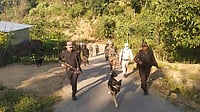Following the earthquake in Nepal that killed at least six people, experts in India have highlighted that the Himalayan region remains prone to earthquakes.
Experts further noted that better preparations are required in case a major earthquake hits the region in the future.
In the early hours on Wednesday, a 6.6-magniture Earthquake struck Western Nepal. Tremors were also felt in India's Uttarakhand. The National Centre for Seismology (NCS) reported that the epicentre of the earthquake was in Nepal, around 90 kms from Pithoragarh in Uttarakhand.
Senior geophysicist of Wadia Institute of Himalayan Geology Ajay Paul said the Himalayas have come into existence as a result of a collision between Indian and Eurasian plates. He added that due to constant pressure of the Eurasian plate on the Indian plate, strained energy accumulating under it keeps releasing itself from time to time in the form of earthquakes.
"Occurrence of earthquakes due to accumulation of strained energy under the Himalayas is a normal and relentless process. The entire Himalayan region is highly vulnerable to tremors and the strong possibility of a major earthquake is always there," said Paul, adding that the magnitude of future earthquake might be of seven or more on the richter scale.
Paul, however, said the release of strained energy or an earthquake cannot be predicted.
"No one knows when it would happen. It may happen the next moment, the next month, or after 100 years," said Paul.
Four major earthquakes were recorded in the Himalayan region over the past 150 years, including the tremors in Shillong in 1897, in Kangra in 1905, in Bihar-Nepal in 1934, and in Assam in 1950. Despite these pieces of information, nothing can be said about the frequency of earthquakes, said Paul.
An earthquake occurred in Uttarkashi in 1991, followed by one in Chamoli in 1999, and one in Nepal in 2015.
Instead of fearing earthquakes due to their unpredictability, it is important to keep ourselves prepared to deal with them in a better way and minimise the damage they might cause to life and property, said Paul.
He further said the constructions should be earthquake resistant, people should be made aware of what can be done by way of preparations before earthquakes, at the time of their occurence and after they have happened.
Mock drills should be conducted at least once every year, he said, adding that if these things are done, the damages by an earthquake can be reduced by 99.99 per cent.
Citing the example of Japan, Paul said due to its better preparedness, the country does not suffer much damage to life and property despite being constantly hit by medium intensity earthquakes.
He said the Wadia Institute of Himalayan Geology also keeps sending its teams to villages and schools to create awareness about what can be done to minimise the effects of an earthquake.
Another senior geo-physicist at the institute Naresh Kumar said Uttarakhand has been placed in seismic zone IV and V due to its vulnerability to earthquakes. Around 60 earthquake observatories have been set up in Himachal Pradesh and Uttarakhand to register seismic movements round the clock, he said.
(With PTI inputs)


























